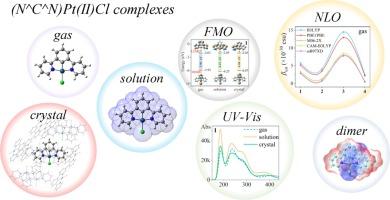关于(N^C^N)Pt(II)Cl 复合物二阶非线性特性周围效应的理论研究
IF 4.3
2区 化学
Q1 SPECTROSCOPY
Spectrochimica Acta Part A: Molecular and Biomolecular Spectroscopy
Pub Date : 2024-10-28
DOI:10.1016/j.saa.2024.125338
引用次数: 0
摘要
铂(II)配合物被广泛用作非线性光学(NLO)材料。通过密度泛函理论(DFT)和时变 DFT 计算,评估了 (N^C^N)Pt(II)Cl 复合物(1-4)的几何和电子结构、二阶 NLO 性能以及紫外可见吸收光谱。利用极化连续体模型(PCM)和量子力学/分子力学(QM/MM)方法分别模拟了溶液和晶体相中总第一超极化率(βtot)的详细环境效应。结果表明,复合物 3 在气相、溶液相和晶体相中都表现出最大的 βtot 值,这可能是由于配体的电子 π 迁移度较高。此外,在复合物 3 中还观察到明显的红移现象,即波长变长。βtot值较大的原因可以用两级模型来合理解释。此外,周围环境对调节二阶 NLO 特性也有重要影响。溶剂效应导致 βtot 值大于气相。分子间相互作用在晶相中发挥着重要作用。由于二聚体的中心对称构型意味着偶极矩(μ)减小,而单体的μ值较大,因此二聚体的形成会降低晶相中单体的βtot 值。希望这项工作能为设计铂(II) NLO 材料提供一些指导。本文章由计算机程序翻译,如有差异,请以英文原文为准。

Theoretical investigation on the surrounding effects of second-order nonlinear properties for (N^C^N)Pt(II)Cl complexes
Pt(II) complexes are widely used as nonlinear optical (NLO) materials. The geometric and electronic structures, second-order NLO property and UV–Vis absorption spectra of (N^C^N)Pt(II)Cl complexes (1–4) N^C^N binding by central benzene and two lateral N-heterocycles) are evaluated by density functional theory (DFT) and time-dependent DFT calculations. The detailed environmental effect of total first hyperpolarizability (βtot) in the solution and crystal phases is simulated by polarized continuum model (PCM) and quantum mechanics/molecular mechanics (QM/MM) method, respectively. The results highlight that the complex 3 exhibits largest βtot value in the gas, solution and crystal phases which can be attributed to the higher electron π-delocalization of ligands. Further, an evident red shift towards longer wavelength is observed for the complex 3. The origin of larger βtot value can be reasonably interpreted by the two-level model. In addition, the surrounding exerts an important influence on modulating second-order NLO properties. The solvent effect results in the larger βtot value than that of gas phase. The intermolecular interaction plays an important role in crystal phase. The formation of dimer can reduce the βtot value in comparison with the βtot value of the monomer in the crystal phase, because the centrosymmetric configuration of dimer implies a decrease of dipole moment (μ) in contrast to the large μ value of monomer. It is expected that this work will provide some guidance for designing Pt(II) NLO materials.
求助全文
通过发布文献求助,成功后即可免费获取论文全文。
去求助
来源期刊
CiteScore
8.40
自引率
11.40%
发文量
1364
审稿时长
40 days
期刊介绍:
Spectrochimica Acta, Part A: Molecular and Biomolecular Spectroscopy (SAA) is an interdisciplinary journal which spans from basic to applied aspects of optical spectroscopy in chemistry, medicine, biology, and materials science.
The journal publishes original scientific papers that feature high-quality spectroscopic data and analysis. From the broad range of optical spectroscopies, the emphasis is on electronic, vibrational or rotational spectra of molecules, rather than on spectroscopy based on magnetic moments.
Criteria for publication in SAA are novelty, uniqueness, and outstanding quality. Routine applications of spectroscopic techniques and computational methods are not appropriate.
Topics of particular interest of Spectrochimica Acta Part A include, but are not limited to:
Spectroscopy and dynamics of bioanalytical, biomedical, environmental, and atmospheric sciences,
Novel experimental techniques or instrumentation for molecular spectroscopy,
Novel theoretical and computational methods,
Novel applications in photochemistry and photobiology,
Novel interpretational approaches as well as advances in data analysis based on electronic or vibrational spectroscopy.

 求助内容:
求助内容: 应助结果提醒方式:
应助结果提醒方式:


